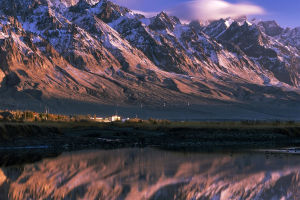The terraced rice fields in the mountainous regions of north-west Vietnam are a marvel of human ingenuity and hard work, representing the culmination of the labor and knowledge of the ethnic minorities living in the region.
These spectacular terraces traverse the mountain slopes and create an awe-inspiring landscape that attracts tourists from all over the world.
The provinces of An Pui, Hoa Binh, and Dien Bien are known for their beautiful rice fields and are a must-visit for anyone traveling to Vietnam.
The rice fields in northwest Vietnam are not only a breathtaking visual experience but also a reflection of the agricultural acumen of the ethnic minorities residing in the area. These communities have mastered a complex rice cultivation system that leverages the region's hilly landscape and copious rainfall to yield premium quality rice, vital for sustaining their communities. The terraced rice fields form a crucial element of the local economy, serving as a source of livelihood and employment for the farmers and their families.
The peak time to witness the rice fields' spectacular beauty in north-west Vietnam is between September and October. In this period, the rice plants adopt a golden hue, setting the fields aglow with a warm, orange radiance. This striking scene, set against the backdrop of a clear blue sky and fluffy white clouds, offers a mesmerizing contrast that captivates the senses. Consequently, it is during these months that tourists are drawn to the region in large numbers, eager to behold this magnificent sight and engage with the local culture and traditions.
Beyond the stunning landscapes of the rice fields, visitors to north-west Vietnam are treated to the region's distinctive local cuisine, deeply influenced by its geography and cultural heritage. The ethnic minorities in this area have cultivated a rich and diverse culinary tradition that mirrors their profound connection to the land and their history. Delicacies such as sticky rice and black chicken soup are culinary experiences not to be missed by any visitor.
The cultural immersion extends beyond the palate, as tourists have the opportunity to engage with the traditional customs and practices of the ethnic minorities in the region. These communities boast a vibrant cultural heritage, encompassing unique festivals, traditional crafts, and music.
Visitors can experience traditional dances, engage in craft-making workshops, and gain insights into the customs and beliefs of the locals. These enriching experiences provide a window into the lives of the people who have cultivated the rice fields of north-west Vietnam across generations, offering a deeper understanding and appreciation of their enduring connection to the land.
In summary, the rice fields of north-west Vietnam represent a spectacular natural marvel, emblematic of the creativity and diligence of the ethnic minorities residing in the region. These terraced fields are much more than a stunning visual treat; they are an integral part of the area's economy and cultural identity.
The optimal time to visit this region is from September to October, a period when the rice fields are transformed into a resplendent golden canvas, creating an awe-inspiring scene against the backdrop of a clear blue sky and white clouds.
A journey to the rice fields of north-west Vietnam offers more than just the chance to behold an extraordinary landscape. It is an invitation to delve into the local culture and engage with the rich traditions of the ethnic communities that have nurtured these lands for generations.
This experience is not just a feast for the eyes but also a profound immersion into a unique and enduring way of life.


